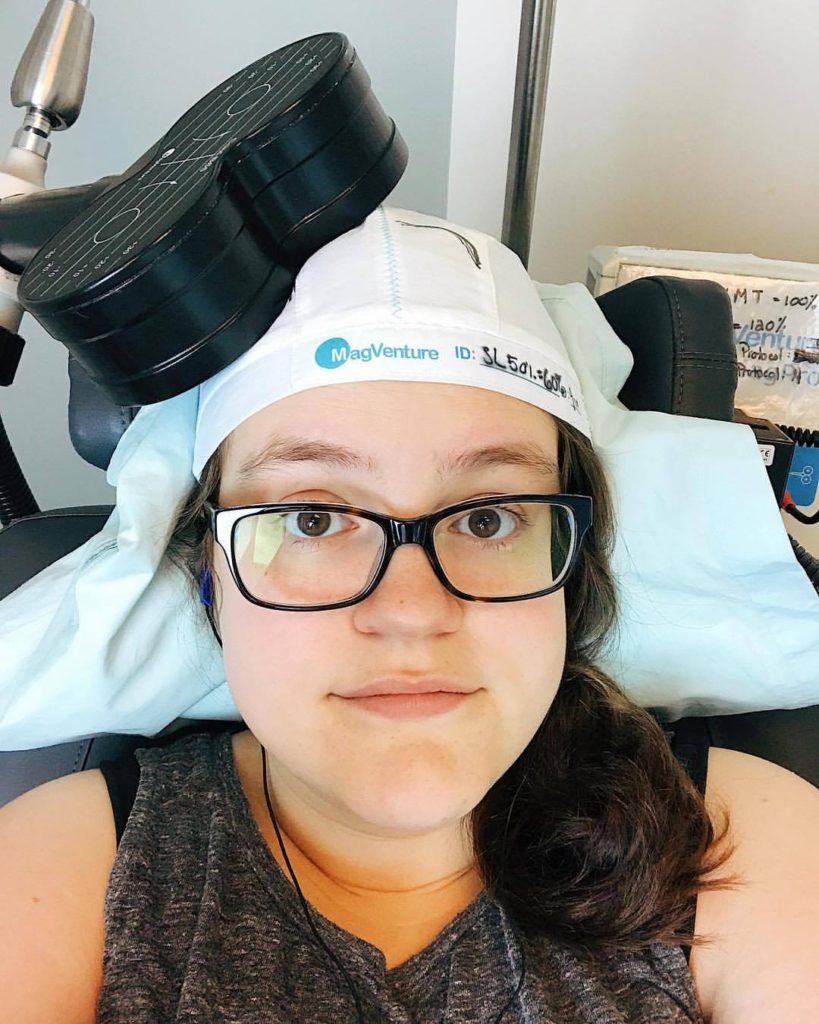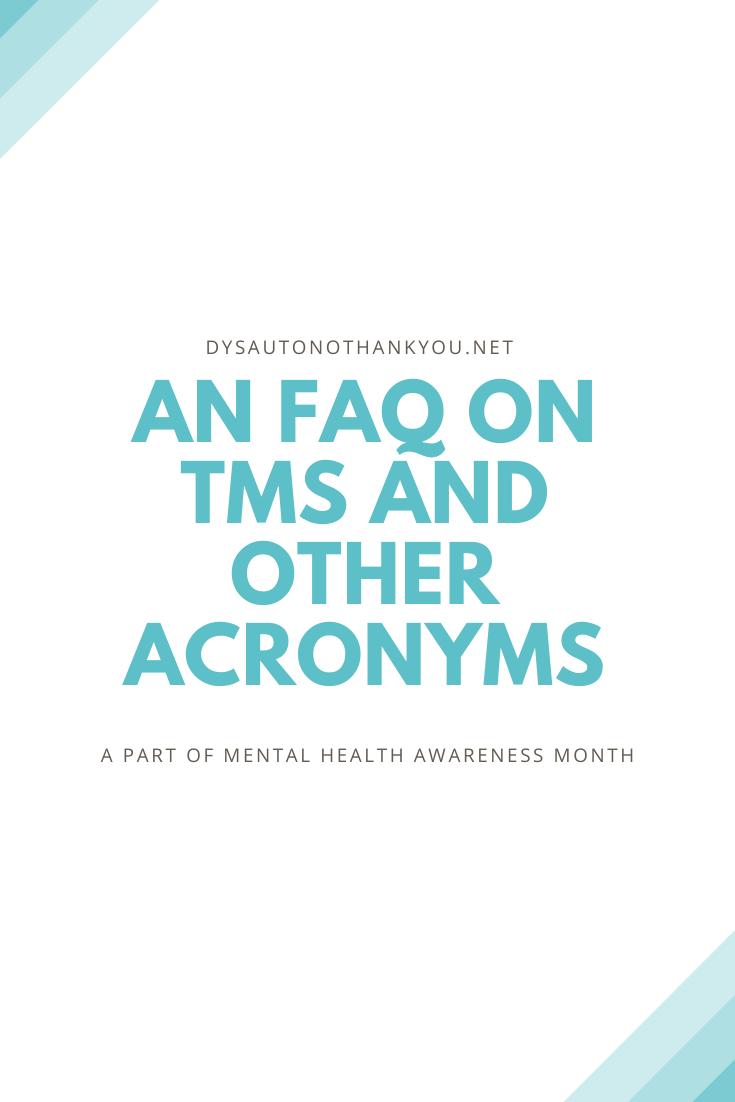Two years ago, I told you about my experience with TMS, Transcranial Magnetic Stimulation. I told you how it pulled me out of depression like nothing I’d ever experienced before. How I relapsed, but I was waiting on insurance to approve another round.
Since then, a lot has changed.
In the Fall of 2016, I started a steady pattern of TMS that lasted a little over a year. We tried lots of different patterns, protocols, treatments. My doctor has been incredible, generous, patient, and kind. The technicians at my treatment center have been next level wonderful to me.
And last January, while I wasn’t feeling as fantastic as I did after my first round, we decided to give TMS a break and see how I’d do.
I stabilized. I’ve been steady for months. (Knock on wood, pray we don’t jinx anything.) I stumble a lot, but I keep picking back up. And I firmly believe it’s because of this last year’s work.
I reference TMS ALL the time, and wanted to answer a lot of questions people might have. And even if you don’t, here’s some answers anyway.

What is TMS?
TMS is a type of therapy for treatment resistant depression. It sends magnetic pulses to parts of the brain that control your mood.
As my treatment center, Greenbrook TMS, explains it:
TMS Therapy works by delivering magnetic pulses to specific areas of the brain involved in mood regulation – areas known to be underactive in those diagnosed with MDD. The magnetic pulses stimulate brain cells, thereby improving the brain’s ability to regulate mood.
Does it hurt?
Kind of. Really, it’s more annoying than painful.
It feels like a woodpecker is tapping at your head and trying to get through your skull to get to your brain. It’s frustrating. It sounds weird. But you get to watch TV, so that’s a plus.
The first few sessions leave you a little sore and uncomfortable, but Advil will fix it right up.
I can’t stress enough though how fast you get used to it. At first, I swore up, right, down, left that I’d never be able to withstand that awful machine. By Week Two, I was taking naps during treatment.
brain magnet level: expert. fell asleep during TMS today.
— shannon linford (@shannern) October 18, 2016
What are the side effects?
Scalp discomfort, headache, neck pain.
The only noticeable thing that happens to me during treatment is twitching of the face and hands. I’m an abnormally twitchy patient (any twitching can usually be alleviated by repositioning the magnet, but my TMS techs and I gave up a long time ago because no matter what, I just twitch.)
There is a small risk of seizure with TMS, but those who administer it are trained in how to respond.
So, is this ECT (electroconvulsive therapy)?
Absolutely not.
ECT uses electrical currents to induce seizures and “restart” your brain or reverse a lot of symptoms of depression. TMS sends magnetic pulses to your brain to stimulate different parts of your brain associated with mood.
They’re VERY different. ECT requires anesthesia and must be done in a hospital under the care of a team of doctors. TMS can be done in doctors’ offices by trained technicians. (Although your initial appointment where measurements for “motor thresholds” are taken are done by doctors.)
You are awake the entire time you have TMS and have full control of your faculties.
Does it work?
For me, yeeeeeeep. And for a lot of people, yeeeeeeep.
How long do you have to get treatment for?
The standard course of treatment is 5 days a week for 6 weeks, and then a few extra visits to taper off and for maintenance.
Your doctor will decide on what “protocol” to give you. I’ve had many protocols… the most standard is probably a 40 minute treatment on one side of the head. You might get a second treatment on the other side for 20 minutes. I’ve had one protocol called “Thetaburst” on a machine called the MagVenture that only lasted about 7 minutes.
It totally depends on the machine, the doctor, and what you’re being treated for—anxiety, depression, both, etc.
Do you have to stop taking your anti-depressants or stop going to therapy?
Nope! I’m still on several of the same medications I was on when I started TMS in January of 2016. Follow the advice of your TMS psychiatrist and your regular psychiatrist and communicate with them.
The most important part of TMS is that you have an aftercare plan. Continue seeing a regular psychiatrist and therapist when you leave, to continue good mental health practices, and the second you notice something is wrong, get right back in to see your TMS physician.
Didn’t you have this and then relapse a bunch?
Yes. And then I went back to TMS.
And it worked again.
When I first started TMS, I was told I had a 70% chance of relapse given my medical predispositions, but a 90% chance of TMS working again. I did it anyway, because honestly, those odds are still pretty good.
I know everyone is looking for the magic thing that works once and works for good, but that might not exist given the nature of what we’re treating. I was watching 60 Minutes, and a psychiatrist, Dr. Charlie Welch, explained it perfectly: “the nature of depression is that it is usually a relapsing illness.”
It’s true. I have relapsed more times than I can count with this illness throughout my life, which is why now that I’ve found the treatment that alleviates pain the best, I’m not letting go.
A lot of medications don’t work on me. It’s always very “guess and check.” But TMS is much more consistent. It keeps working, just like how Cognitive Behavioral Therapy has been steady with me, it just needed something else to boost it.
But how can you say it worked? How do you know it worked? How can it be working if you keep relapsing?
When I relapse, I go into a state where I physically and emotionally cannot function in the world. I withdraw. I stay in my room out of fear, not enjoyment. I don’t engage with my family, my dogs, my friends. I don’t respond to texts, tweets, posts, anything—because just holding myself together and just breathing is too much.
There are varying degrees of relapse for me, but the worst is when I feel too scared to talk to my parents. I know I need help the most when I’m the most afraid to ask for it.
When I’m good, when therapy, medication, everything works? I’m not necessarily jumping off the walls happy (although sometimes I’m laughing hysterically at my own jokes)—but I’m in and a part of the world. I’m running errands. I’m driving myself places. I’m making plans. I’m responding to texts (or forgetting to because I’m actually busy.) I’m doing laundry and making dinner or getting Orange Chicken at Panda Express. I’m procrastinating something and binge watching ER because it’s FUN, not because it’s my only coping mechanism.
When I go from hibernation to living, and living for extended periods of time, that’s how I know TMS is working.
What are the requirements to get TMS?
I can’t speak for all treatment centers and insurance companies, but I had to verify that I’d undergone Cognitive Behavioral Therapy, had tried at least four different medications in the past (try 25+), and my psychiatrist wrote a referral for me.
People with metallic objects in their heads are ineligible for TMS.
And the most important question…
Why do you keep writing about TMS, a depression treatment, on your blog about dysautonomia?
When I was 21, I was supposed to get ECT.
It took me months to come to that decision. It was one of the scariest and hardest decisions I ever made.
When my psychiatrist first told me he wanted me to have ECT, I started hyperventilating, crying and nearly ran out of his office. (I was instantaneously reciting Sylvia Plath while scenes from One Flew Over the Cuckoo’s Nest played in my head. NOT PLEASANT.) My doctor calmed me down, explained what modern day ECT is like, WOW we’ve made progress, and told me he really believed this could change my life for the better.
I spent an entire summer talking with my family and my therapist about the decision—I learned how safe it was, but I also learned the risks, and I finally decided I was ready. That I was going to have it, I was going to get better and finally beat depression.
And then my cardiologist who treats my POTS told me in no uncertain terms I was not to undergo ECT. That he would not be signing off on it. That while it’s incredibly safe for the average person, it was too risky with my POTS. We needed to find something else.
I went back to my psychiatrist. I was broken. I had been so ready for this huge step, and now it was whisked away. For over half of my life, I had tried everything to fix my depression, and now my last option, ECT, had been taken from me.
That’s when we started talking about TMS. It had never been in the picture before because it wasn’t covered by our insurance at the time and the out of pocket cost was $15,000.
At the time of that initial conversation, I was stable. We did everything we could to sustain it, and it lasted about a year. And that’s when we turned to the insurance company, got TMS approved (by the grace of God), and started the process in January of 2016, when I was 23 years old.
Long story short:
Many psychiatrists believe ECT is the most effective way to help patients with severe treatment resistant depression. But for many patients who also suffer from dysautonomia, it’s just not an option.
But TMS *is.*
And it’s a really, really, really good one.
*
Sources

Thank you! I have depression, POTS, and derealization. Did it put your pots in remission?
Hey Sarah! TMS didn’t really interact with my POTS. It didn’t improve my symptoms, but it didn’t worsen any of them.
HOWEVER, by improving the depression, it’s allowed me to take better case of POTS.
All my best wishes to you!!!